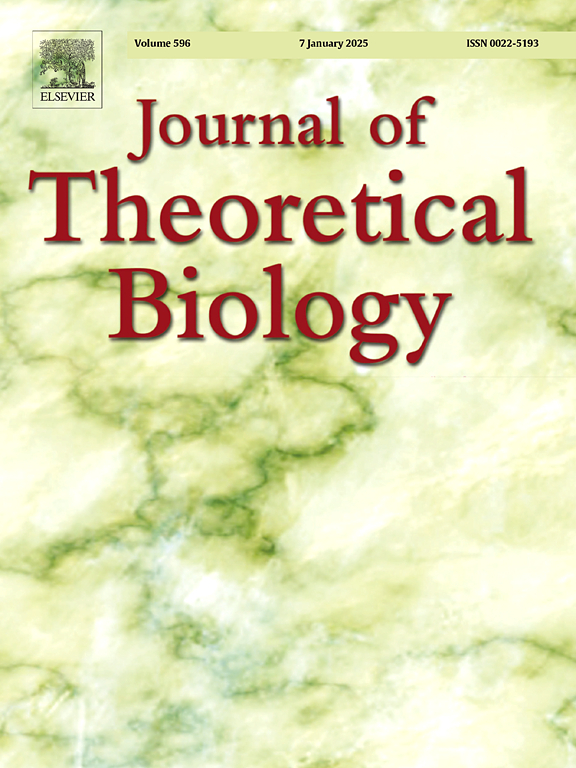多细胞系统中基于细胞位置的细胞力学特性评价
IF 1.9
4区 数学
Q2 BIOLOGY
引用次数: 0
摘要
测量细胞-细胞相互作用的机械力对于研究多细胞生物不同三维形态的出现是重要的。我们之前报道了一种基于图像的统计方法,用于推断细胞-细胞相互作用的有效成对力(即吸引力/排斥力),其中细胞颗粒模型与实时成像获得的细胞跟踪数据相匹配。然而,由于颗粒模型是一个粗粒度模型,因此尚不清楚成对力如何与包括细胞-细胞粘附力在内的亚细胞机械成分相关。在这里,我们将我们的推理方法应用于由假设亚细胞成分的顶点模型生成的细胞跟踪数据。通过这种方法,我们研究了有效的成对力与各种亚细胞成分之间的关系:细胞-细胞粘附力、细胞表面张力、细胞-细胞外基质(ECM)粘附力、细胞与ECM之间的牵引力、细胞生长等。我们发现细胞间的粘附力是吸引的,而细胞表面张力和细胞- ecm的粘附力都是排斥的,等等。这些结果表明,亚细胞机械成分可以促进细胞-细胞相互作用的有效吸引力/排斥力。这一综合分析为将成对力与亚细胞力学成分联系起来提供了理论基础:这一展示有助于从细胞位置信息推测亚细胞力学成分,并有助于解释基于粒子模型的模拟结果。本文章由计算机程序翻译,如有差异,请以英文原文为准。
Cell position-based evaluation of mechanical features of cells in multicellular systems
Measurement of mechanical forces of cell–cell interactions is important for studying the emergence of diverse three-dimensional morphologies of multicellular organisms. We previously reported an image-based statistical method for inferring effective pairwise forces of cell–cell interactions (i.e., attractive/repulsive forces), where a cell particle model was fitted to cell tracking data acquired by live imaging. However, because the particle model is a coarse-grained model, it remains unclear how the pairwise forces relates to sub-cellular mechanical components including cell–cell adhesive forces. Here we applied our inference method to cell tracking data generated by vertex models that assumed sub-cellular components. Through this approach, we investigated the relationship between the effective pairwise forces and various sub-cellular components: cell–cell adhesion forces, cell surface tensions, cell–extracellular matrix (ECM) adhesion, traction forces between cells and ECM, cell growth, etc. We found that the cell–cell adhesion forces were attractive, and both the cell surface tensions and cell–ECM adhesive forces were repulsive, etc. These results indicate that sub-cellular mechanical components can contribute to the effective attractive/repulsive forces of cell–cell interactions. This comprehensive analysis provides theoretical bases for linking the pairwise forces to the sub-cellular mechanical components: this showcase is useful for speculating the sub-cellular mechanical components from the information of cell positions, and for interpreting simulation results based on particle models.
求助全文
通过发布文献求助,成功后即可免费获取论文全文。
去求助
来源期刊
CiteScore
4.20
自引率
5.00%
发文量
218
审稿时长
51 days
期刊介绍:
The Journal of Theoretical Biology is the leading forum for theoretical perspectives that give insight into biological processes. It covers a very wide range of topics and is of interest to biologists in many areas of research, including:
• Brain and Neuroscience
• Cancer Growth and Treatment
• Cell Biology
• Developmental Biology
• Ecology
• Evolution
• Immunology,
• Infectious and non-infectious Diseases,
• Mathematical, Computational, Biophysical and Statistical Modeling
• Microbiology, Molecular Biology, and Biochemistry
• Networks and Complex Systems
• Physiology
• Pharmacodynamics
• Animal Behavior and Game Theory
Acceptable papers are those that bear significant importance on the biology per se being presented, and not on the mathematical analysis. Papers that include some data or experimental material bearing on theory will be considered, including those that contain comparative study, statistical data analysis, mathematical proof, computer simulations, experiments, field observations, or even philosophical arguments, which are all methods to support or reject theoretical ideas. However, there should be a concerted effort to make papers intelligible to biologists in the chosen field.

 求助内容:
求助内容: 应助结果提醒方式:
应助结果提醒方式:


